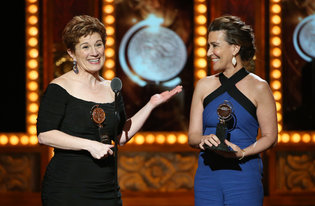available for purchase
at this time.
Link Roundup! – 7/17/15
Link Roundups feature articles and bits of internet goodness that our dramaturgy team digs up. If you find something you want to send our way, drop us a line on Facebook or Twitter!
♦♦♦♦♦

Lisa Kron, left, and Jeanine Tesori accepting a Tony Award for best score, for their collaboration on “Fun Home.” Credit Sara Krulwich/The New York Times
The New York Times has a story about The Count — a study that tracks the number of female-written productions that are done each year.
Overseen by the playwrights Julia Jordan and Marsha Norman, the study, called “The Count,” is to be updated each year. Until now, besides a handful of older analyses, it had been unclear just how many female playwrights were seeing their work staged, according to Ms. Jordan.
“We wanted to create a baseline,” she said, “and to document the change.”
Judging from the numbers, the picture for women is rosier than a decade ago. A 2002 report from the New York State Council on the Arts found that 17 percent of productions across the country had female playwrights. According to the new report, that figure now sits at 22 percent.
♦♦♦♦♦
The ongoing conversation about the way theatre critics handle race in their reviews is continued in this article by Diep Tran for American Theatre, which gives four ways critics can be less racist:
We theatre journalists are a marginalized minority ourselves: overworked, underpaid, and constantly fighting to justify our existence. We’re not all that different from the artists we claim to love. And if we really love theatre, then we need to find a better way to talk about the diverse people who make it. Because right now, we—whose job it is to tell the truth—are failing at it.
♦♦♦♦♦

Photograph: Agencja Fotograficzna Caro/Alamy
The struggle between parenthood and a living in the arts is the focus of this piece for The Guardian:
Very quickly I realised that all the shows, openings and parties inconveniently started at the same time: the dreaded “bath and bed” hour, when you and your child are in tatters.
I got tired of making excuses and started to ignore invitation emails and phone calls. The creative world felt like a lonely place. In spite of the richness of motherhood, I felt like a poor artist. As literary critic and writer Cyril Connolly snobbishly asserted back in the 1930s: “There is no more sombre enemy of good art than the pram in the hall.”
♦♦♦♦♦
A few recent, high profile cases of cell phone use in the theater have caused quite the online firestorm. This piece from The Clyde Fitch Report takes an interesting perspective on the issue:
If we really want theater to become a vibrant part of our culture again, I think we need to get over this obsession about quiet. Playwrights ought to write plays as if they are going to be performed in noisy bars or in a middle-school lunchroom — plays that are so dynamic that it is impossible to look away to check Facebook, plays that are so noisy that hearing a ringtone is impossible. Actors need to be taught methods of acting that don’t involve going into a trance, methods that allow them to interact with the spectators, to step out of character and banter with them if required, to be present in the same place with the audience breathing the same air, hearing the same sounds, sharing an experience. That’s what makes theater unique. If the audience wants to be ignored, film does it way better than theater ever can. We can’t compete. So instead, do what film can’t do: turn the lights up in the house, acknowledge the presence of the audience, and make theater together.